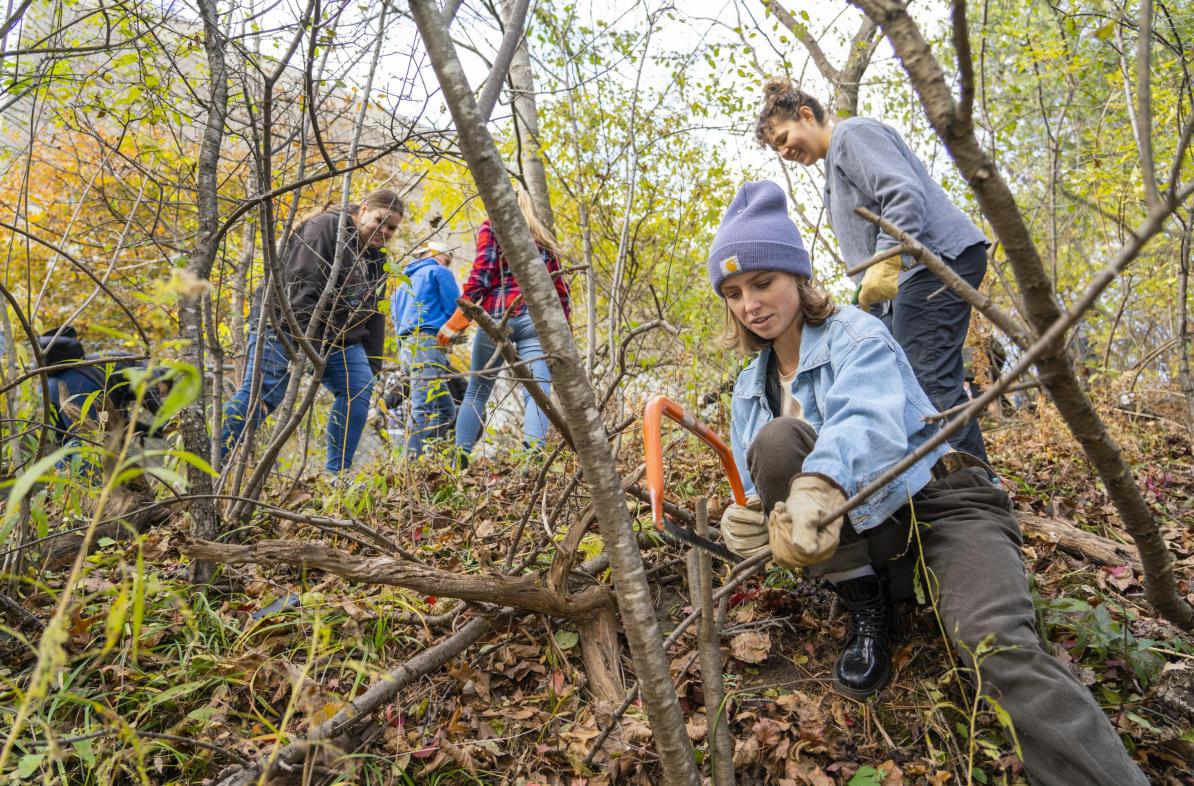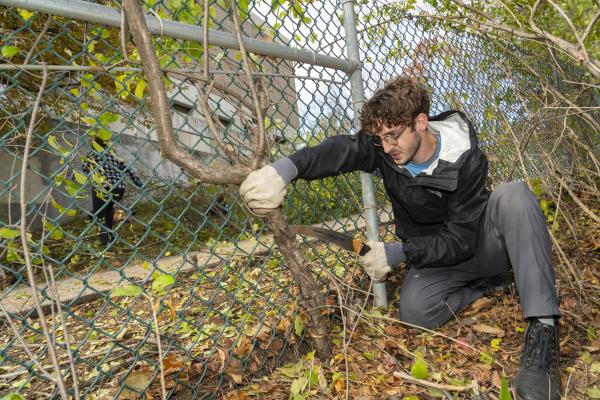
Biology faculty, students lead effort to remove invasive species from Putnam Park
Julia Inman knew from her biology classes that common and glossy buckthorn are invasive plants that can disrupt the ecosystem, harming native plants and wildlife.
However, spending an afternoon identifying and removing the invasive plants from the natural area that runs through her University of Wisconsin-Eau Claire campus took the Blugold’s understanding to a whole new level. The project — part of her conservation biology class — also is helping her see how she can help combat the invasive species problem in Putnam Park and elsewhere.
UW-Eau Claire students and faculty were among those working to preserve the biodiversity in Putnam Park.
“I knew buckthorn is an invasive plant that gets in the way of the natural ecosystem in Putnam Park and in places all over Wisconsin,” says Inman, a senior ecology and environmental biology major and geography minor who also is earning a geospatial certificate. “But coming out here and seeing the sheer amount of it that is present is eye-opening. It’s helping me realize how important it is to be educated about invasive species and to learn about different ways to get rid of it.
“I’m planning to go into some kind of conservation work, where I hope to be doing things just like this to preserve our natural ecosystems, so this is really interesting.”
Inman’s new way of thinking about the invasive species problem and her role in solving it is exactly why Dr. Paula Kleintjes Neff, the professor of biology who teaches Inman’s conservation class, regularly immerses her students in fieldwork like removing buckthorn from Putnam Park.
Through these projects, her students gain knowledge about conservation issues, and they learn to work as part of a team to help address real-world environmental problems in Wisconsin, Kleintjes Neff says.
“They are learning about protecting biological diversity and they’re doing meaningful work at the same time,” Kleintjes Neff says. “It helps them see we can be a voice and hands to help manage these places where biodiversity can be lost.”
Working to protect the local ecosystem
Inman and other Blugolds in Kleintjes Neff’s conservation biology class recently spent more than two hours removing buckthorn from an upper area of Putnam Park. They worked alongside UW-Eau Claire classmates and professors, as well as horticulture instructors and students from Chippewa Valley Technical College. The city of Eau Claire’s forester, who teaches at CVTC, also joined the effort., as did Daria Hutchinson, a landscape architect in UW-Eau Claire’s Facilities department.
Together, they worked to cut the buckthorn down, remove it and apply herbicides to the stumps to discourage it from growing back.
Buckthorn, an invasive species brought to Wisconsin from Europe, has taken over many natural areas in the state, threatening the natural biological ecosystem in places like Putnam Park. It blocks sunlight from native species and adds chemicals to the soil that inhibit growth of native plants.
“There are just a lot of negative impacts on the entire ecosystem, so we’re looking to help with it,” says Inman, a native of North Branch, Minnesota. “Buckthorn can provide habitat and food, but it’s so invasive that this one species takes over and provides only one type of habitat and food source.”
Buckthorn’s seeds spread quickly, so it can threaten many of the native plants, trees and wildlife that make Putnam Park such a special place, says David May, a native of Menomonee Falls who also is in Kleintjes Neff’s biology conservation class.
“It has an impact on the entire community structure of a forest,” May says of the invasive plants. “As a consequence, it also prevents lots of native birds like robins from nesting in those areas.”

Biology student David May was among the Blugolds helping to remove buckthorn, an invasive plant, from Putnam Park.
May, an ecology and environmental biology major with a minor in marine science who also is pursuing a geospatial certificate, says it’s a “privilege” to be part of a project that helps to protect Putnam Park.
“It’s a great, beautiful, well-protected and untouched area,” May says of Putnam Park. “There are not a lot of intact and untouched ecosystems left, so it’s a privilege to do work to protect it.”
Giving students real-world experiences
The Buckhorn removal project is one of many field-based activities Kleintjes Neff has organized for her students during her more than 25 years of teaching at UW-Eau Claire.
The projects vary from collecting or planting prairie seeds at sites throughout Wisconsin to monitoring plants and birds with Beaver Creek Reserve to removing invasive species in the Chippewa Valley.
“I’ve always been a professor who believes in hands-on learning,” Kleintjes Neff says. “I want my students to know that we can help manage some of these places that are experiencing biodiversity loss. If there are little bits that we can do to reduce the impact of invasive species, habitat fragmentation, climate change or over-exploitation of species, we’re all going to do our little part.”
Participating in projects that make a positive impact on the world around her, such as this fall’s buckthorn removal project, are incredible learning experiences, Inman says.
“This project really applies everything that we talk about in the classroom,” Inman says of her work in Putnam Park. “This is real-world conservation. We spend lectures talking about the impact of invasive species but seeing firsthand what we’re talking about is powerful.
“Before this project, it seemed like going after invasive species would be a tough task. How would I tell what’s invasive? Now I know it’s not as difficult as I thought it would be. We need to be educated so we can see it and remove it. A big takeaway from this project for me is that now I know I can do it.”
May appreciates that Kleintjes Neff and other UW-Eau Claire professors offer opportunities to put the lessons he’s learning in the classroom into action in the field. Working on these projects has him even more excited about his future career, he says.
“Any day I get to go out and participate in field research and come closer to working as a scientist in the scientific community is a great day for me,” May says.
While conservation projects are important everywhere, the work students do in Putnam Park has special meaning because the space is so important to people on and off campus, Kleintjes Neff says.
“Putnam Park is valuable to our campus and to the surrounding areas, so protecting its biodiversity is especially meaningful,” Kleintjes Neff says. “It’s extremely valuable as an aesthetic, recreational and spiritual space. People come here to take a run, admire the wildflowers, bird watch or take a walk. It’s a wonderful resource, so we do our part to keep it that way.”
Community effort
Whenever she plans fieldwork for her students, Kleintjes Neff tries to include other groups or organizations in the effort.
“Many hands make lighter work,” Kleintjes Neff says. “It also teaches teamwork and collaboration, which is how conservation is done. Learning by doing is meaningful and memorable. I’m proud when I see my past students and alumni involved in projects long after they’ve been in my classes.”
The shared effort also is helpful to students as they prepare to begin their careers. After graduation, many alumni stay in the area to work in jobs in and near Eau Claire. Planning projects that bring current students together with area professionals can create opportunities for students to make connections that will help them as they begin their careers.
May says students recognize and appreciate the opportunity to work with people outside the university.
“It’s not just about our class, but about the cooperation between UW-Eau Claire, CVTC and the broader community,” May says of the field projects. “We’re teaming up to remove buckthorn, but we’re also promoting the idea of community connections and coming together. That’s a great thing to be part of.”
Inman agrees, saying its “fantastic” to spend time working alongside CVTC students and others when doing conservation projects.
“It helps get the word out in different areas of the community that these projects aren’t just a university thing,” Inman says. “We’re helping to spread awareness about the idea that everyone can help. It’s not just conservation biology students who can do this work. It can be anyone.”
The conservation projects also help students build their resumes and gives them meaningful topics to talk about during job interviews.
And partnering with Hutchinson and UW-Eau Claire’s grounds crew on some projects gives students opportunities to “help keep this beautiful campus beautiful and to conserve the biodiversity on campus,” Kleintjes Neff says.
Matt Staudenmaier, who oversees the city of Eau Claire’s forestry program and teaches at CVTC, says it’s exciting to see students and faculty from two Eau Claire higher education institutions work together on conservation projects, such as removing invasive species from Putnam Park, a place that’s so important to many in the community.
“Students are seeing this isn’t just a one and done project,” Staudenmaier says “Their work has a long enduring benefit to the park, the university and the community. They can come back and see how things are going. They can see the tangible difference they’ve made.”
UW-Eau Claire and other groups have long been engaged in conservation efforts for many years, Staudenmaier says. Their efforts make a difference, he says.
That the city of Eau Claire has had a “Tree City USA” designation for more than 40 years, and both UW-Eau Claire and CVTC now have “Tree Campus USA” designations from the Arbor Day Foundation reflects that commitment, says Staudenmaier, noting that Eau Claire is the only Wisconsin city to have multiple campuses with that distinction.
“It’s really a win-win for everyone,” Kleintjes Neff says of partnering with others on conservation projects. “This is how conservation is done. We walk the talk.”
You may also like


